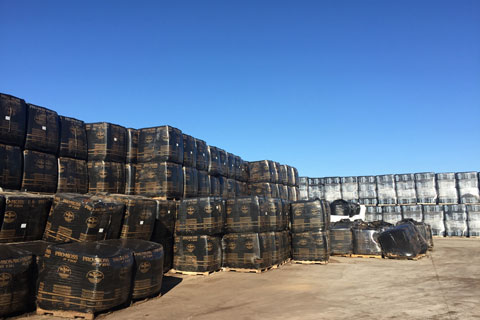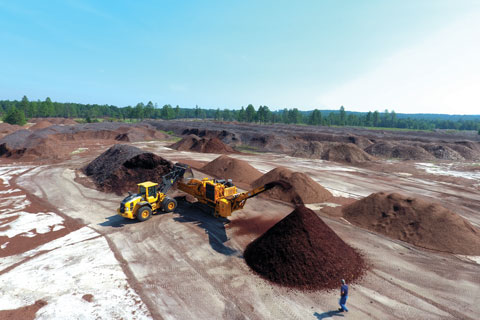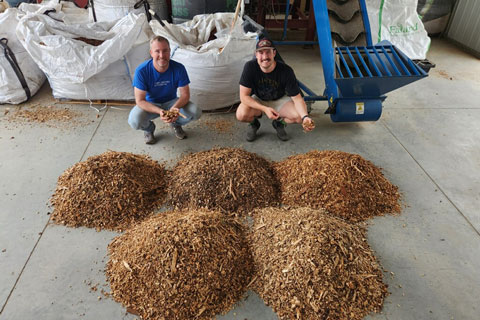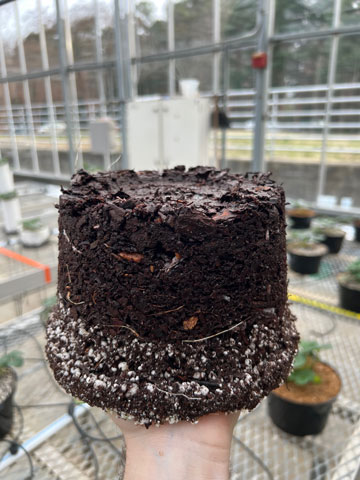1/1/2024
Making Your Peat Go Farther
Dr. Brian E. Jackson

The 2023 annual peat harvest (extraction) report released in September by the Canadian Sphagnum Peat Moss Association (CSPMA) revealed that peat producers in Canada were unable to harvest a significant amount of the peat this year that they’d forecasted. This is a result of rainy weather across Canada for much of the summer, as well as the fires in the east that we likely all remember hearing about.
Figure 1: Inventory peat supplies. Photo: Brian Jackson.
This news has caused some concerns and questions from growers and other peat consumers about the supply, availability and cost of peat looking ahead to 2024. The CSPMA, along with many of the individual peat companies, have made public statements about the less-than-desirable harvest this year, but have expressed confidence that they’ll work with their customers to provide the various growing media products they need.
Some peat is being sourced by Canadian suppliers from European peat producers (which had a much better overall harvest season in Summer 2023) to help cover the shortages, in addition to a heavier reliance on other growing media components to make the quantities of mixes needed. With the European harvest being pretty strong this year, coupled with the current sea freight prices (pre-pandemic levels), many growers may find these sources to be options in 2024 as they place orders for the year ahead.
Some options
The extent of peat shortages to be felt by some growers is yet to be seen, but there are some options that growers can consider if needed. The growers most affected may be those who purchase raw (100%) sphagnum peat to make their own mixes or who need pure peat for certain crops like mushrooms. Sourcing raw peat has been increasing difficult, if not impossible, with steep price increases ever since 2020, a trend not likely to end anytime in the future.
 The first thing growers have done (should do) is take inventory of the peat supplies still on hand (Figure 1). Many growers across the U.S. over-ordered last year due to increased projections of crop production (which may not have happened, leaving unused inventory on site) or as an insurance policy to ensure they had more peat than needed due to past supply shortages. If 2023 inventory is still available, be aware that if the product had wetting agents (surfactants), starter charge fertilizers, biologicals, etc., they likely could have diminished in some way, so check prior to potting.
The first thing growers have done (should do) is take inventory of the peat supplies still on hand (Figure 1). Many growers across the U.S. over-ordered last year due to increased projections of crop production (which may not have happened, leaving unused inventory on site) or as an insurance policy to ensure they had more peat than needed due to past supply shortages. If 2023 inventory is still available, be aware that if the product had wetting agents (surfactants), starter charge fertilizers, biologicals, etc., they likely could have diminished in some way, so check prior to potting.
Figure 2: Aged and processed pine bark used in soilless mixes. Photo: Brian Jackson.
Another “safeguard” when needing to extend or stretch peat supplies in mixes is the reliable use of coconut coir and aged bark products. In the past two to three years, several peat companies (i.e., SunGro acquiring Pelemix and Profile’s acquisition of Nivetha Exporters in 2022) have acquired coir companies as part of their business model, which means more coir available for use in mixes. Other North American-based coir companies have continued to expand their product offerings (volume and crop-specific products), including FibreDust, iCoir, Agrococo, Didihu and Coir America, among others.
Bark (aged or composted) is by no means a new material, but it continues to be used in greater quantities for greenhouse peat-based mixes. Bark remains king of substrates in the outdoor container production world (ornamental woody nursery crops and now the emerging markets of soilless blueberry, blackberry and raspberry production), but it can be used at significant levels in many types of greenhouse mixes. Some bark producers (i.e., Pacific Organics in North Carolina) are innovating new products via processing technologies to create specific (marketed) alternatives to peat moss using 100% bark. Bark producers (Figure 2) are abundant throughout the Southeast and Pacific Northwest, as well as up the eastern seaboard into Canada (i.e., Ontario). From these supply centers, bark is trucked to other regions across the U.S. or barged up the Mississippi (when droughts don’t hinder shipping routes).
 Figure 3: Dr. Brian Jackson (left) and graduate student Jack Bobo look at wood chips from different conifer species being processed for testing as growing media components. Photo: Brian Jackson.
Figure 3: Dr. Brian Jackson (left) and graduate student Jack Bobo look at wood chips from different conifer species being processed for testing as growing media components. Photo: Brian Jackson.
Wood products, no longer a novelty to many growers, continue to expand their offerings across the U.S. as well. New products will be hitting the market in 2024 (in some capacity/regions) to offer growers more options. PR Russell Mulch and Soil company was the first in the U.S. to install Premier Tech’s new wood fiber machine in late 2023 and is now fully operational. Premier Tech’s wood fiber machine is the latest of many new technologies being offered to substrate manufacturers (and even growers) to produce wood fiber.
Other (mostly European) refining machines are also ramping up production (Agaris in France, Promeco in Italy, EnTapa in Spain, Clextral in France, Hunton in Norway, UPM in Finland, just to name a new). TimberFiber is another new product/company, based in Texas, that debuted their wood fiber product at Cultivate’23.
Hammer-milled wood products also continue to increase in demand/interest due to their economics and simplified processing requirements. Research in the Horticultural Substrates Lab at North Carolina State University continues to develop SOPs on hammer-milling applications and has expanded research efforts in 2023-2024 to test more conifer species (compared to the one or two currently being used as feedstock for substrate production) to further the potential for forest products to be used on the west coast and up into Canada (Figure 3).
Other (future) possibilities
Our efforts are also exploring new technologies and pre-conditioning techniques to re-evaluate the use of hardwood trees and by-products—materials that in the past were deemed unusable due to performance issues when used as a substrate. Expanding the pallet of forest product options will better enable wood fiber production in areas across North America, which will reduce transport costs, utilize local/regional resources, boost local economies and give better supply security to growers.
Substrate components that aren’t wood, bark or coir are continuing to increase in commercialization and use across the growing media industry as viable additions to peat. Bagasse (common in the Gulf States) has re-emerged as a material with potential based on its physical properties and abundance in certain regions. Recent publications in 2023 furthered our understanding of its use and limitations as a component in peat-based mixes for shorter-term crops.
Companies like Pittmoss continue to increase product development and sales of their recycled paper fiber products, which can be used with or without peat. Biochar and other allied products also continue to increase in appearance at trade shows, on LinkedIn, in grower magazines and at professional trade shows across the U.S. In addition to a mountain of published research on biochar’s potential use in substrates, SunGro Horticulture introduced their new professional mix, named Black Bear, at Cultivate’23, which has biochar as a key ingredient.
 Figure 4: Stratified substrate with bark on the bottom of containers to reduce the amount of peat needed/used. Photo: Brandan Shur.
Figure 4: Stratified substrate with bark on the bottom of containers to reduce the amount of peat needed/used. Photo: Brandan Shur.
Many companies (and more coming) are seeking entry into the growing media market. The other fiber material with growing (national and international) interest in its use in growing media is miscanthus (and other similar perennial grasses). Thousands of acres of miscanthus were planted across North America (more in Europe) when it was thought the annual biomass it yields would be a valued feedstock for biofuels and oils. Well, that didn’t exactly pan out as expected, so now there’s a glut of this biomass (insert hemp fiber/stalk/biomass here as well) available without a home. Research across the world, including at NC State, is heavily involved in re-investigating these materials to create substrate components for short rotation crop production.
Other strategies to extend peat supplies, if needed or wanted, include the stratification technique—the use of cheaper or more readily available substrate materials in the lower half/portion of containers with the top portion (where the plant/plug/seed is planted) being peat (Figure 4). This approach, developed and extensively researched by Drs. Jeb Fields (LSU) and Jim Owen (USDA-Wooster), has been focused on use in nursery production systems as an approach to improve water and nutrient efficiency, but it’s gained interest as a peat reduction strategy in the greenhouse production world.
In summary, if the peat harvest of 2023 does create product shortages in 2024, the growing media industry (led by peat producers) is resilient enough and well equipped with alternative materials, and growers are ingenious and creative in their production strategies to overcome most major shortfalls and product demands. GT
Brian E. Jackson is a Professor and Director of the Horticultural Substrates Laboratory at NC State University. Brian can be reached at Brian_Jackson@ncsu.edu.